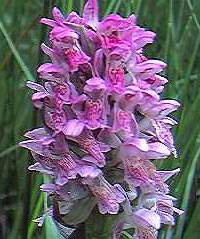
This orchid seems to be a hybrid between Northern Marsh and Common Spotted Orchids, both of which were growing nearby in a bog in Newtondale. The Dactylorhiza group are particularly prone to inter-breeding, and intermediate plants are frequent. The pinkish D. incarnata was also present, so this plant may have charactersitics from three rather than two species. 5.7.2000.
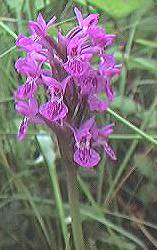
One of the easier Dactylorhiza orchids to identify, as it has a characteristic deep purple colour, and the flowers are in a very dense spike.
 Close up (right) the flowers have beautiful markings, and the short spur can be seen. Northern marsh orchids, like other marsh orchids, have a rather succulent, fleshy look about them. Ryedale is close to the southern limit of the distribution of these lovely plants, but they are quite common in some of the marshes in the north of our area.5/7/2000.
Close up (right) the flowers have beautiful markings, and the short spur can be seen. Northern marsh orchids, like other marsh orchids, have a rather succulent, fleshy look about them. Ryedale is close to the southern limit of the distribution of these lovely plants, but they are quite common in some of the marshes in the north of our area.5/7/2000.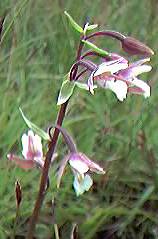
 A beautiful, uncommon orchid of marshes, usually neutral or limy, up to a foot or so tall with relatively large flowers (see detail, right). This specimen was one of two growing near Dalby. 5/7/2000.
A beautiful, uncommon orchid of marshes, usually neutral or limy, up to a foot or so tall with relatively large flowers (see detail, right). This specimen was one of two growing near Dalby. 5/7/2000.
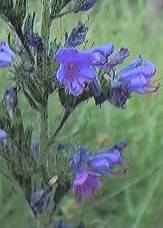 A striking plant about a foot tall with intense blue flowers (see detail right). The whole plant is roughly hairy, almost spiky, and rather stiff. It is not common, and grows on thin soils, usually on the limestone with short grasses. This plant was on the side of a forest road near Ellerburn. 5/7/2000.
A striking plant about a foot tall with intense blue flowers (see detail right). The whole plant is roughly hairy, almost spiky, and rather stiff. It is not common, and grows on thin soils, usually on the limestone with short grasses. This plant was on the side of a forest road near Ellerburn. 5/7/2000.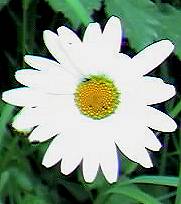
Dog daisies form a wonderful show in early summer, often along roadside verges (for instance between Hovingham and Stonegrave) The flowers are over an inch across, like small garden marguerites, borne singly on stalks a foot or so high. 5/7/2000.
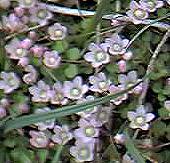
A delicate little plant growing in boggy areas on the moors, bog pimpernel has pale shell-pink flowers; this was a particularly good plant with many blooms, growing near the railway in Newtondale. It is related to the familiar scarlet pimpernel, and like it the flowers open in the sunshine. 5/7/2000.
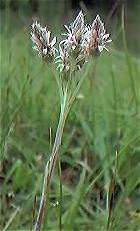
A rare plant in Ryedale, this is on the southern limits of its range here.
 A small, silvery plant some 4" tall with pink flowers, the males and females on separate plants. Mountain everlasting grows in short turf; this plant and its neighbours seemed to have a preference for molehills, and could only be found in a very small area of what seemed to be very similar meadowland, on fairly neutral soil. Unfortunately it flowered early this year, and had almost gone over by the time we got to see and photograph it! 5/7/2000
A small, silvery plant some 4" tall with pink flowers, the males and females on separate plants. Mountain everlasting grows in short turf; this plant and its neighbours seemed to have a preference for molehills, and could only be found in a very small area of what seemed to be very similar meadowland, on fairly neutral soil. Unfortunately it flowered early this year, and had almost gone over by the time we got to see and photograph it! 5/7/2000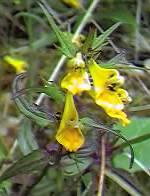
A curious little plant of dry heathy woodland and moorland, a semi-parasite like many of its relatives such as eyebright and bartsia. The yellow flowers always appear in pairs, usually leaning to one side. This plant was growing on a forest track verge in Newtondale.5/7/2000.
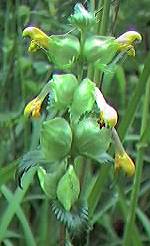
A semi-parasite like its cousin cow wheat, hay rattle has a very characteristic inflated calyx, which enlarges in fruit; the seeds rattle about inside, hence the name. Once very common in traditional hay meadows, this plant has suffered from agricultural “improvements”, and is now to be found in forgotten corners, dry grassy verges, the edges fo forest tracks etc. 5/7/2000.
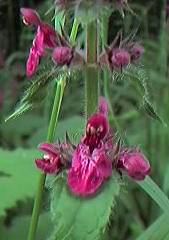
A common summer plant of hedge-bottoms, woods and as a garden weed, easily recognised by the strong, rather unpleasant smell given off if the plant is crushed. The flowers are a deep wine-red or purple, two-lipped like mint. The leaves are similar to those of dead nettles, but can instantly be told apart by the smell. 5/7/2000.
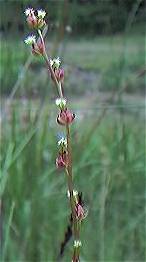
 A strange plant loosely related to the rushes, marsh arrowgrass grows in damp limy meadows, and is not common (it may be overlooked, being green and inconspicuous...).About a foot tall, the long thin seed-pods which develop below the flowers are the most notable feature. 5/7/2000
A strange plant loosely related to the rushes, marsh arrowgrass grows in damp limy meadows, and is not common (it may be overlooked, being green and inconspicuous...).About a foot tall, the long thin seed-pods which develop below the flowers are the most notable feature. 5/7/2000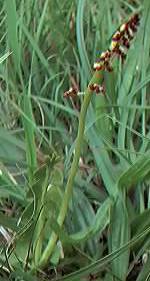
This curious plant, about 4" tall, is in fact a kind of fern, the “flower” actually being the spore-bearing body. An inconspicuous plant of grassland, this specimen was growing in a neutral-to-limy meadow. It has one pinnately lobed “leaf” below the spore-bearing part. (cf. Adderstongue which also grows in grassland and is a similar little fern but with undivided leaves.5/7/2000.
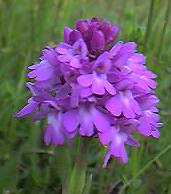
A striking orchid of high summer, with dense spikes of pink or pale purple flowers, each with a long spur. Only likely to be confused with fragrant orchid, but quickly told by the lack of scent (and also the much denser spikes). A lime-lover, pyramidal orchids grow in unimproved meadows and similar grassland, including some roadside verges, for instance north of Hutton-le-Hole. 12/7/2000.
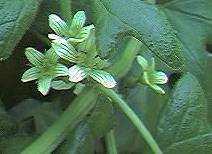
 The only member of the cucumber or melon family to grow wild in Britain, white bryony is not related to black bryony. It is on the northern edge of its range in Ryedale, and is uncommon, growing in hedges. The beautifully veined greenish flowers develop into red berries in the autumn, when the plant is very conspicuous. This fine specimen is in a hedge near Ellerburn. 12/7/2000.
The only member of the cucumber or melon family to grow wild in Britain, white bryony is not related to black bryony. It is on the northern edge of its range in Ryedale, and is uncommon, growing in hedges. The beautifully veined greenish flowers develop into red berries in the autumn, when the plant is very conspicuous. This fine specimen is in a hedge near Ellerburn. 12/7/2000.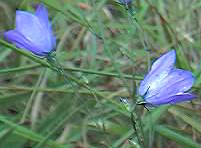
A very familiar plant of summer in Ryedale, growing on grassy slopes and sunny banks on the moors and southern hills alike. The classic bellflower, the blooms vary from pale to deep sky blue, and are very graceful on their thread-like stalks as they wave in the wind (which makes taking their photo very hard!). 12/7/2000.
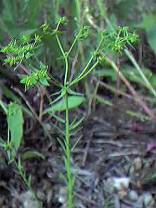
A small, inconspicuous green plant, its chief interest is as a traditional cornfield weed, and as such now quite rare. This specimen, along with several others, was found in a set-aside field on Cauklass Bank, in association with other “weeds” such as cornsalad. It is an annual, and presumably the seeds can remain viable in the soil for many years. 12/7/2000.
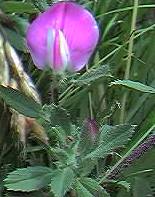
An attractive low shrub with pink peaflowers, restharrow occurs in meadows, on grassy verges etc. The plant is often covered in sticky, glandular hairs, and grows up to a foot or so tall. 12/7/2000.
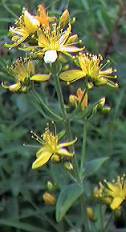
One of the St. John’s Worts, of which there are several in Ryedale, probably the hairy one, H. hirsutum Unfortunately I forgot to note the species at the time, and it is impossible to tell from the photo! It was growing in grassland at the edge of a wood. 12/7/2000.
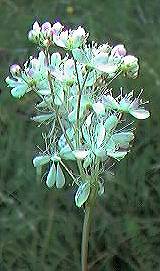
Related to meadowsweet, but much less common and without the scent, dropwort grows in meadows and downland on limestone. An uncommon plant in Ryedale, this specimen was recorded near Ellerburn. 12/7/2000.
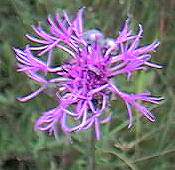
A glorious flower of summer on the limestone, greater knapweed provides a wonderful show in meadows and on grassy verges on lime, for instance round Stonegrave. It is closely related to the common knapweed, but the flowers have extended rays like cornflowers, and are much larger, up to 2" across, and a very particular rich purple. 12/7/2000.
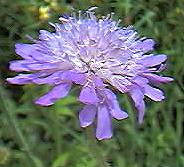
An indicator of limy soils, field scabious grows profusely in meadows and on roadside verges which have escaped spraying or the drift of fertilisers etc. The flowers are over an inch across, and vary from a delicate pink through pale blue to deep sky blue. Common on the southern limestone, field scabious often grows with greater knapweed. 12/7/2000.
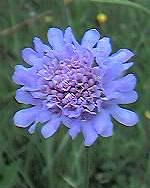
Less common than field scabious, but growing in similar places on lime-rich turf, lesser scabious is altogether smaller and more delicate, with finely-divided leaves and usually bluer flowers. 21/7/2000.
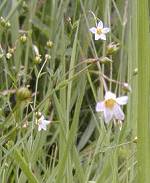
A small, delicate plant, closely related to the blue flax grown for seed. Fairy Flax is usually under 6" tall, with tiny white flowers on thread-like stalks. It is common on forest rides and tracksides and similar dry places. 12/7/2000.
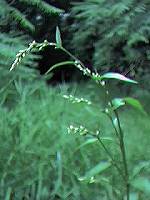
A rather undistinguished, weedy plant up to a foot or so tall, growing in damp areas such as along woodland rides. The leaves have a hot taste, much like chilli. Related to Redleg and Bistort. 27/7/2000.
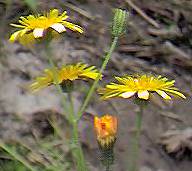
One of several dandelion-like yellow composites, this one has several flowers on a branched stalk, and the calyx bracts form a kind of frill or ruff round the base of the flowers. Very common in grassland of all types, and flowering over a fairly long period. 27/7/2000
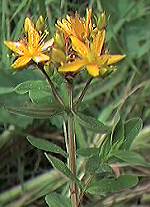
One of the common Hypericum species growing in Ryedale, this one preferring damper comditions such as tracksides and ditches. The stems are definitely square, with four wings, one on each angle. The leaves have translucent veins when held up to the light, and tiny translucent dots which may only be visible when magnified. The yellow flowers are very similar to other members of the family. 27/7/2000
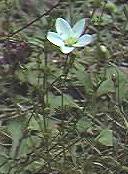
A weedy plant only a few inches tall, with thread-like stems and tiny leaves; there are hard nodes or “knots” up the stem, hence the name. The flowers are relatively large for the size of the plant, up to about a third of an inch across, and pure white. Superficially resembling a saxifrage, this plant is actually related to the chickweeds. 27/7/2000
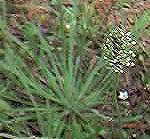
A curious little plant up to about 6" tall, with pinnately lobed leaves. The flowers are recognisably those of a plantain, but the plant as a whole is quite different. Normally this is a coastal plant, but specimens can be found along dryish forest tracks, possibly brought in with the roadstone. This plant is one of a group of a dozen or so growing on a forest ride near Gilling. 27/7/2000
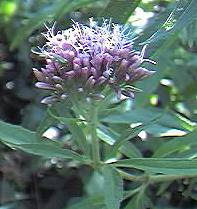
Neither a hemp nor an agrimony this rather untidy-looking plant is fairly common in wet woodland in Ryedale. It grows up to 4' or so, and the pale purple flowers are a great attraction for late summer butterflies such as red admirals, peacocks, commas etc. Hemp Agrimony is actually a composite (i.e. Daisy family) but this is not immediately apparent. 25/8/2000
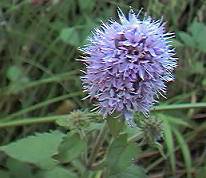
The mints are a difficult group because they hybridise very readily. This is a typical water mint, with a roundish cluster of flowers at the top of the stem. A very common plant in ditches, along stream- and pond-edges, in damp woods and other moist habitats. A mint growing in a wet place will probably be either water mint or one of its hybrids (some of which have extra whorls of flowers down the stem, or a more pointed flower-spike). 25/8/2000
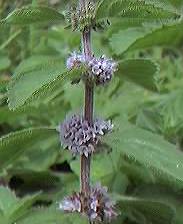
The common wild mint of drier habitats, distinguished by the whorls of flowers up the stem with no terminal cluster (cf. Water mint above). The plant is softly hairy all over, usually about 6"-8" tall and has a rather milder scent than many other mints. 30/8/2000
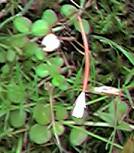
A curious little creeping plant only an inch or so tall, this Epilobium does not resemble any of its close reatives except in the form of the pale pink flowers and the resulting long seed-pods. It is an uncommon plant, originally from New Zealand and apparently a garden escape, colonising damp ditches along roadsides. The photo is rather larger than life-size! 30/8/2000
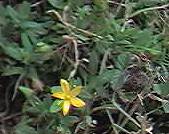
A delightful small plant only a couple of inches tall, and often creeping along the ground, very hard to see unless the star-like yellow flowers are open. This little Hypericum is not uncommon along woodland rides and on heathy banks. It is not immediately recognisable as a St. John’s Wort except by the flowers. 30/8/2000
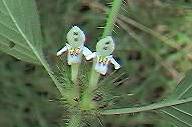
Rather like a dead-nettle, but with bristly hairs and long bare stretches of stem between the pairs of leaves. The flowers are most often pinkish, but they can be cream or white as in this example, with beautiful markings on the lower lip. Fairly common in woods, on verges, the edges of cropfileds etc. 30/8/2000
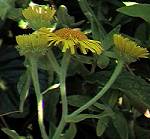
 A yellow daisy which is commoner in the east of our area, especially near the coast, Fleabane usually grows in masses (see right), in damp meadows, marshes, ditches etc. 30/8/2000
A yellow daisy which is commoner in the east of our area, especially near the coast, Fleabane usually grows in masses (see right), in damp meadows, marshes, ditches etc. 30/8/2000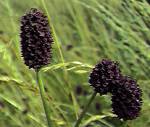

 Now rather uncommon, great burnet is a perennial plant of damp grassland. The picture (left) shows a clump (actually a single plant) amongst grasses. Growing up to two feet or so it has attractive pinnate, toothed leaves, and striking flower-heads like elongated dark red balls (see detail right). This particular plant was growing along the old railway line near Gilling. 1/8/2001
Now rather uncommon, great burnet is a perennial plant of damp grassland. The picture (left) shows a clump (actually a single plant) amongst grasses. Growing up to two feet or so it has attractive pinnate, toothed leaves, and striking flower-heads like elongated dark red balls (see detail right). This particular plant was growing along the old railway line near Gilling. 1/8/2001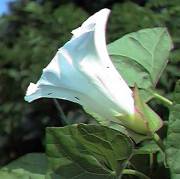
Hedge bindweed is the larger of the two common native inland bindweeds. It is a frequent sight clambering over hedges and in scrub, although in Ryedale its larger (introduced) relative (C. sylvatica) is actually commoner. The native species is altogether daintier, and can be told by the two “flaps” or bracts below the calyx not overlapping, and revealing the true calyx. 1/8/2001
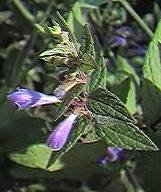
Skullcap is a pretty little plant with clear blue flowers growing in pairs up its stems, which are a foot or so long. It grows in wet places such as lake or pond margins, riverbanks and ditches. This specimen was thriving at the water’s edge of the lake at Gilling. 1/8/2001
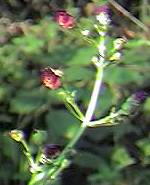
Water figwort is a somewhat unprepossessing plant, along with its close relative Common figwort (S. nodosa). Both have square stems some two to three feet tall, that of the water variety being winged, and small reddish-brown flowers which develop into nobbly fruits shaped like tiny figs, hence the name. Both grow in damp woodland, with the water figwort preferring wetter spots such as ditches. 1/8/2001

Weld is a plant of roadside verges, field margins and other disturbed ground such as set-aside land, especially on limy soils. Growing a couple of feet tall, it has a rather stiff habit, with narrow spikes of yellow-green flowers (see detail right). It often appears one year and disappears the next. It is fairly common, especially on the limestone in the south of Ryedale. This specimen was growing in a trackside verge near Gilling. 1/8/2001
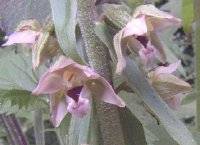
This orchid is probably overlooked as it is ver inconspcuous if not in flower. The spikes are a foot or so tall, and the colour can vary from pale greenish to pink. The plant was one of a colony found in 2005 near Castle Howard (admittedly just outside the RNHS area, but it probably occurs within as well!) growing in the verge of a farm lane with woodland behind. For more pictures see Helleborines at Whitwell. 23/7/2005
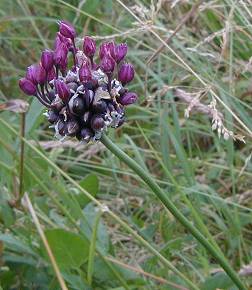
This wild relative of garlic is uncommon in Ryedale, and not easy to spot as it is prctically invisible when not in flower. The more or less spherical flower-heads are about an inch across and consist of a mixture of purple flowers and small bulbils. This gives the plant two ways of reproducing: by seed from the flowers, and vegetatively by the bulbils which behave like tiny onion sets. This specimen was part of a colony of 30 or so plants growing in a verge on limestone, but it also grows under trees in scrubby woodland. 23/7/2005